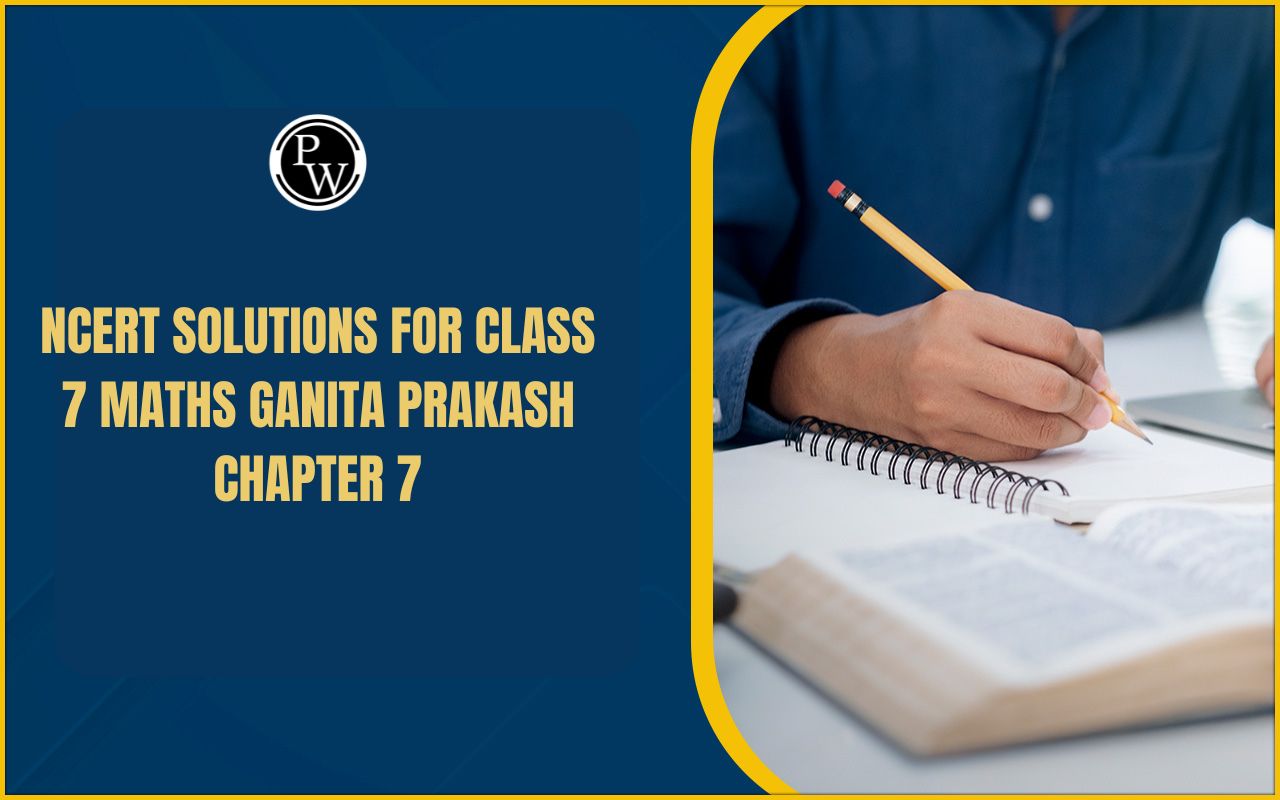

NCERT Solutions for Class 7 Maths Chapter 1
NCERT Solutions for Class 7 Maths Chapter 1: In Class 7 Maths Chapter 1, "Integers," students learn about positive and negative whole numbers. Our NCERT solutions provide step-by-step explanations and answers for all the exercises in this chapter.
We cover many topics, like what integers are, adding and subtracting them, their properties, and more. Each question is explained in detail, but it's easy to understand so you can learn well. By using our NCERT Solutions , you'll gain the confidence and accuracy to tackle integer-related problems. Our solutions also give you extra tips to make problem-solving easier and improve your math skills.NCERT Solutions for Class 7 Maths Chapter 1 Integers PDF
You can access the PDF for NCERT Solutions for Class 7 Maths Chapter 1 - Integers through the provided link. This PDF contains detailed solutions to all the exercises and problems in the chapter. These solutions are designed to help students understand and solve integer-related questions with ease and accuracy. By referring to these NCERT Solutions, students can strengthen their understanding of integers and improve their mathematical skills.NCERT Solutions for Class 7 Maths Chapter 1 Integers PDF
NCERT Solutions for Class 7 Maths Chapter 1 Integers
Exercise 1.1 Page: 4
1. Following number line shows the temperature in degree celsius (c o ) at different places on a particular day.

(a) Observe this number line and write the temperature of the places marked on it.
Solution:-
By observing the number line, we can find the temperature of the cities as follows: The temperature in Lahulspiti is -8 o C The temperature in Srinagar is -2 o C The temperature in Shimla is 5 o C The temperature in Ooty is 14 o C The temperature in Bengaluru is 22 o C(b) What is the temperature difference between the hottest and the coldest places among the above?
Solution:-
From the number line, we observe that The temperature at the hottest place, i.e., Bengaluru, is 22 o C The temperature at the coldest place, i.e., Lahulspiti, is -8 o C Temperature difference between hottest and coldest place is = 22 o C – (-8 o C) = 22 o C + 8 o C = 30 o C Hence, the temperature difference between the hottest and the coldest place is 30 o C.(c) What is the temperature difference between Lahulspiti and Srinagar?
Solution:-
From the given number line, The temperature in Lahulspiti is -8 o C The temperature in Srinagar is -2 o C ∴ The temperature difference between Lahulspiti and Srinagar is = -2 o C – (8 o C) = – 2 O C + 8 o C = 6 o C(d) Can we say the temperature of Srinagar and Shimla, taken together, is less than the
temperature in Shimla? Is it also less than the temperature in Srinagar?
Solution:-
From the given number line, The temperature in Srinagar =-2 o C The temperature in Shimla = 5 o C The temperature of Srinagar and Shimla, taken together, is = – 2 o C + 5 o C = 3 o C ∴ 5 o C > 3 o C So, the temperature of Srinagar and Shimla, taken together, is less than the temperature at Shimla. Then, 3 o > -2 o No, the temperature of Srinagar and Shimla, taken together, is not less than the temperature of Srinagar.2. In a quiz, positive marks are given for correct answers and negative marks are given
for incorrect answers. If Jack’s scores in five successive rounds were 25, – 5, – 10,
15 and 10, what was his total at the end?
Solution:-
From the question, Jack’s score in five successive rounds are 25, -5, -10, 15 and 10 The total score of Jack at the end will be = 25 + (-5) + (-10) + 15 + 10 = 25 – 5 – 10 + 15 + 10 = 50 – 15 = 35 ∴ Jack’s total score at the end is 35.3. At Srinagar temperature was – 5°C on Monday, and then it dropped by 2°C on Tuesday. What was the temperature of Srinagar on Tuesday? On Wednesday, it rose by 4°C. What was the temperature on this day?
Solution:-
From the question, The temperature on Monday in Srinagar = -5 o C The temperature on Tuesday in Srinagar dropped by 2 o C = Temperature on Monday – 2 o C = -5 o C – 2 o C = -7 o C The temperature on Wednesday in Srinagar rose by 4 o C = Temperature on Tuesday + 4 o C = -7 o C + 4 o C = -3 o C Thus, the temperature on Tuesday and Wednesday was -7 o C and -3 o C, respectively.4. A plane is flying at the height of 5000 m above sea level. At a particular point, it is exactly above a submarine floating 1200 m below sea level. What is the vertical distance between them?

Solution:-
From the question, The plane is flying at a height = 5000 m Depth of submarine = -1200 m The vertical distance between plane and submarine = 5000 m – (- 1200) m = 5000 m + 1200 m = 6200 m5. Mohan deposits ₹ 2,000 in his bank account and withdraws ₹ 1,642 from it the next day. If the withdrawal of the amount from the account is represented by a negative integer, then how will you represent the amount deposited? Find the balance in Mohan’s account after the withdrawal.
Solution:-
Withdrawal of the amount from the account is represented by a negative integer. Then, the deposit of the amount to the account is represented by a positive integer. From the question, Total amount deposited in bank account by the Mohan = ₹ 2000 The total amount withdrawn from the bank account by the Mohan = – ₹ 1642 Balance in Mohan’s account after the withdrawal = amount deposited + amount withdrawn = ₹ 2000 + (-₹ 1642) = ₹ 2000 – ₹ 1642 = ₹ 358 Hence, the balance in Mohan’s account after the withdrawal is ₹ 358.6. Rita goes 20 km towards the east from point A to point B. From B, she moves 30 km towards the west along the same road. If the distance towards the east is represented by a positive integer, then how will you represent the distance travelled towards the west? By which integer will you represent her final position from A?

Solution:-
From the question, it is given that A positive integer represents the distance towards the east. Then, the distance travelled towards the west will be represented by a negative integer. Rita travels a distance in the east direction = 20 km Rita travels a distance in the west direction = – 30 km ∴ Distance travelled from A = 20 + (- 30) = 20 – 30 = -10 km Hence, we will represent the distance travelled by Rita from point A by a negative integer, i.e., – 10 km7. In a magic square, each row, column and diagonal have the same sum. Check which of the following is a magic square .

Solution:-
First, we consider the square (i) By adding the numbers in each row, we get = 5 + (- 1) + (- 4) = 5 – 1 – 4 = 5 – 5 = 0 = -5 + (-2) + 7 = – 5 – 2 + 7 = -7 + 7 = 0 = 0 + 3 + (-3) = 3 – 3 = 0 By adding the numbers in each column, we get = 5 + (- 5) + 0 = 5 – 5 = 0 = (-1) + (-2) + 3 = -1 – 2 + 3 = -3 + 3 = 0 = -4 + 7 + (-3) = -4 + 7 – 3 = -7 + 7 = 0 By adding the numbers in diagonals, we get = 5 + (-2) + (-3) = 5 – 2 – 3 = 5 – 5 = 0 = -4 + (-2) + 0 = – 4 – 2 = -6 Because the sum of one diagonal is not equal to zero. So, (i) is not a magic square Now, we consider the square (ii) By adding the numbers in each row, we get = 1 + (-10) + 0 = 1 – 10 + 0 = -9 = (-4) + (-3) + (-2) = -4 – 3 – 2 = -9 = (-6) + 4 + (-7) = -6 + 4 – 7 = -13 + 4 = -9 By adding the numbers in each column, we get = 1 + (-4) + (-6) = 1 – 4 – 6 = 1 – 10 = -9 = (-10) + (-3) + 4 = -10 – 3 + 4 = -13 + 4 = 0 + (-2) + (-7) = 0 – 2 – 7 = -9 By adding the numbers in diagonals, we get = 1 + (-3) + (-7) = 1 – 3 – 7 = 1 – 10 = -9 = 0 + (-3) + (-6) = 0 – 3 – 6 = -9 (ii) square is a magic square because the sum of each row, each column and the diagonal is equal to -9.| CBSE Syllabus Class 7 | |
| CBSE Class 7 English Syllabus | CBSE Class 7 Math Syllabus |
| CBSE Class 7 Social Science Syllabus | CBSE Class 7 Science Syllabus |
8. Verify a – (– b) = a + b for the following values of a and b.
(i) a = 21, b = 18
Solution:-
From the question, a = 21 and b = 18 To verify a – (- b) = a + b Let us take Left Hand Side (LHS) = a – (- b) = 21 – (- 18) = 21 + 18 = 39 Now, Right Hand Side (RHS) = a + b = 21 + 18 = 39 By comparing LHS and RHS LHS = RHS 39 = 39 Hence, the value of a and b is verified.(ii) a = 118, b = 125
Solution:-
From the question, a = 118 and b = 125 To verify a – (- b) = a + b Let us take Left Hand Side (LHS) = a – (- b) = 118 – (- 125) = 118 + 125 = 243 Now, Right Hand Side (RHS) = a + b = 118 + 125 = 243 By comparing LHS and RHS, LHS = RHS 243 = 243 Hence, the value of a and b is verified.(iii) a = 75, b = 84
Solution:-
From the question, a = 75 and b = 84 To verify a – (- b) = a + b Let us take Left Hand Side (LHS) = a – (- b) = 75 – (- 84) = 75 + 84 = 159 Now, Right Hand Side (RHS) = a + b = 75 + 84 = 159 By comparing LHS and RHS, LHS = RHS 159 = 159 Hence, the value of a and b is verified.(iv) a = 28, b = 11
Solution:-
From the question, a = 28 and b = 11 To verify a – (- b) = a + b Let us take Left Hand Side (LHS) = a – (- b) = 28 – (- 11) = 28 + 11 = 39 Now, Right Hand Side (RHS) = a + b = 28 + 11 = 39 By comparing LHS and RHS, LHS = RHS 39 = 39 Hence, the value of a and b is verified.CBSE Board Exam Centre List 2024
9. Use the sign of >, < or = in the box to make the statements true.
(a) (-8) + (-4) [ ] (-8) – (-4)
Solution:-
Let us take Left Hand Side (LHS) = (-8) + (-4) = -8 – 4 = -12 Now, Right Hand Side (RHS) = (-8) – (-4) = -8 + 4 = -4 By comparing LHS and RHS, LHS < RHS -12 < -4 ∴ (-8) + (-4) [<] (-8) – (-4) (b) (-3) + 7 – (19) [ ] 15 – 8 + (-9) Solution:- Let us take Left Hand Side (LHS) = (-3) + 7 – 19 = -3 + 7 – 19 = -22 + 7 = -15 Now, Right Hand Side (RHS) = 15 – 8 + (-9) = 15 – 8 – 9 = 15 – 17 = -2 By comparing LHS and RHS, LHS < RHS -15 < -2 ∴ (-3) + 7 – (19) [<] 15 – 8 + (-9)(c) 23 – 41 + 11 [ ] 23 – 41 – 11
Solution:-
Let us take Left Hand Side (LHS) = 23 – 41 + 11 = 34 – 41 = – 7 Now, Right Hand Side (RHS) = 23 – 41 – 11 = 23 – 52 = – 29 By comparing LHS and RHS, LHS > RHS – 7 > -29 ∴ 23 – 41 + 11 [>] 23 – 41 – 11(d) 39 + (-24) – (15) [ ] 36 + (-52) – (- 36)
Solution:-
Let us take Left Hand Side (LHS) = 39 + (-24) – 15 = 39 – 24 – 15 = 39 – 39 = 0 Now, Right Hand Side (RHS) = 36 + (-52) – (- 36) = 36 – 52 + 36 = 72 – 52 = 20 By comparing LHS and RHS, LHS < RHS 0 < 20 ∴ 39 + (-24) – (15) [<] 36 + (-52) – (- 36)(e) – 231 + 79 + 51 [ ] -399 + 159 + 81
Solution:-
Let us take Left Hand Side (LHS) = – 231 + 79 + 51 = – 231 + 130 = -101 Now, Right Hand Side (RHS) = – 399 + 159 + 81 = – 399 + 240 = – 159 By comparing LHS and RHS, LHS > RHS -101 > -159 ∴ – 231 + 79 + 51 [>] -399 + 159 + 81Related Links -
Exercise 1.2 Page: 9
1. Write down a pair of integers whose:
(a) sum is -7
Solution:-
= – 4 + (-3) = – 4 – 3 … [∵ (+ × – = -)] = – 7(b) the difference is – 10
Solution:-
= -25 – (-15) = – 25 + 15 … [∵ (- × – = +)] = -10(c) sum is 0
Solution:-
= 4 + (-4) = 4 – 4 = 02. (a) Write a pair of negative integers whose difference gives 8
Solution:-
= (-5) – (- 13) = -5 + 13 … [∵ (- × – = +)] = 8(b) Write a negative integer and a positive integer whose sum is – 5.
Solution:-
= -25 + 20 = -5(c) Write a negative integer and a positive integer whose difference is – 3.
Solution :-
= – 2 – (1) = – 2 – 1 = – 33. In a quiz, team A scored – 40, 10, 0 and team B scored 10, 0, – 40 in three successive rounds. Which team scored more? Can we say that we can add integers in any order?
Solution:-
From the question, it is given that The score of team A = -40, 10, 0 Total score obtained by team A = – 40 + 10 + 0 = – 30 The score of team B = 10, 0, -40 Total score obtained by team B = 10 + 0 + (-40) = 10 + 0 – 40 = – 30 Thus, the score of both the A team and B team is the same. Yes, we can say that we can add integers in any order.NCERT Solutions for Class 7 Maths Chapter 1 FAQs
Why are integers important in mathematics?
How can I improve my understanding of integers?
How can NCERT Solutions for Class 7 Maths Chapter 1 - Integers benefit me?












